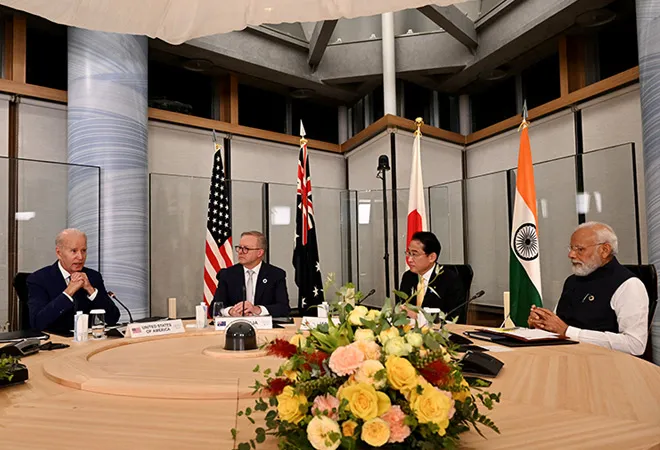
After news surfaced of the Quad Leaders’ Meeting in Sydney being
cancelled, the Quad leaders
met in Hiroshima, Japan on 20 May 2023, on the sidelines of the G7 meeting instead. The primary aim of the Quad is to ensure peace and stability in the Indo-Pacific. The Quad is mostly seen as a grouping dealing with a growing Chinese threat in the region, though the statements and remarks made by the leaders of the four countries are made in a way that points at Chinese expansionist activities without directly calling out China. This Quad meeting was no different in this regard. The joint statement does show a
subtle swipe being taken at China, “We strongly oppose destabilising or unilateral actions that seek to change the status quo by force or coercion. We express serious concern at the militarisation of disputed features, the dangerous use of coastguard and maritime militia vessels, and efforts to disrupt other countries’ offshore resource exploitation activities.”
There were many other statements
released at the end of this Quad meeting besides the joint statement. There was a vision statement, and statements on issues impacting the geostrategic climate of the Indo-Pacific such as cybersecurity, critical and emerging technology, and clean energy supply chains. These statements not only reflect the seriousness of the four Quad countries towards these issues, but they also show the progress that has been made by the working groups created to deal with these subjects during previous Quad meetings. With every meeting, the agenda and the gamut of subjects covered by the Quad have expanded.
The Quad is mostly seen as a grouping dealing with a growing Chinese threat in the region, though the statements and remarks made by the leaders of the four countries are made in a way that points at Chinese expansionist activities without directly calling out China.
This time, the joint statement and the vision statement show additional focus on organisations such as the ASEAN, Pacific Islands Forum (PIF), and the Indian Ocean Rim Association (IORA). Though ASEAN and the need to uphold ASEAN centrality always find a mention in these statements, they appear more as a formality as nothing concrete has been put out with regards to how the Quad countries can do more in the Southeast Asian region and involve the ASEAN more. But, this time, some concrete initiatives have been laid out and the focus has also broadened to include the PIF and the IORA.
ASEAN, PIF, and IORA
The joint statement
underlines that the Quad countries will ensure that their work is aligned with ASEAN’s principles and priorities and will help facilitate the implementation of the ASEAN Outlook on the Indo-Pacific. ASEAN’s leadership role in the region and also in the ASEAN-led organisations, such as the East Asia Summit (EAS) and the ASEAN Regional Forum (ARF), was acknowledged. A special mention was also given to Indonesia’s ongoing chairmanship of the ASEAN along with support and acknowledgement of the theme of its chairmanship, “ASEAN Matters: Epicentrum of Growth”. There will be greater efforts to strengthen individual Quad countries’ relationships with the ASEAN.
The need to do more with the regional institutions of the Pacific, especially the PIF, has been stressed, along with the desire to engage the Quad in initiatives like the 2050 Strategy for the Blue Pacific Continent. Initiatives taken by countries individually at the bilateral and multilateral level have also been cited and appreciated, like the Forum for India-Pacific Islands Cooperation and the third FIPIC Summit that Prime Minister Modi held in Papua New Guinea; Japan’s Pacific Island Leaders’ Meeting; and Australia’s own “deep and enduring commitment to the Pacific” as a founding member of the PIF. The “
Pacific priorities” like climate action, ocean health, resilient infrastructure, maritime security, and financial integrity are areas that the Quad will look to focus on to strengthen its footing in the Pacific.
A new initiative has been announced, ‘Quad Partnership for Cable Connectivity and Resilience,’ the purpose of which is to “strengthen cable systems in the Indo-Pacific, drawing on Quad countries’ world-class expertise in manufacturing, delivering and maintaining cable infrastructure”.
Boosting cooperation and influence in the Indian Ocean Region is also a commitment that the Quad wants to be looking into, especially in helping India take the lead and implement the IORA Outlook on the Indo-Pacific.
Areas of collaboration for the Quad with the ASEAN, PIF, and the IORA
The sectors in which the Quad is looking to
engage with the ASEAN, the PIF, and the IORA are green shipping and ports, disaster risk management, exchanging climate information, and capacity building projects like the Coalition for Disaster Resilient Infrastructure (CDRI) and Infrastructure for Resilient Islands States (IRIS) initiative. Additionally, through the Indo-Pacific Partnership for Maritime Domain Awareness, near-real-time, integrated and cost-effective maritime domain data is being
provided to maritime agencies in Southeast Asia and the Pacific and the coverage will be expanded to partners in the Indian Ocean region in the coming months. The development of resilient infrastructure is the area that is being seen as the most important and where the Quad needs to step in. A new initiative has been
announced, ‘Quad Partnership for Cable Connectivity and Resilience,’ the purpose of which is to “strengthen cable systems in the Indo-Pacific, drawing on Quad countries’ world-class expertise in manufacturing, delivering and maintaining cable infrastructure”.
Why are ASEAN, PIF, and the IORA important for the Quad?
Preserving ASEAN centrality and strengthening ties with the countries of Southeast Asia have been driving the Indo-Pacific policies of all four countries. China’s growing footprints in this region; its strong economic ties with most countries in Southeast Asia; its assertive actions in the disputed waters of the South China Sea; the strategic geography of this region; and that ASEAN and the ASEAN-led organisations are viewed as the predominant regional architecture in the Indo-Pacific—all contribute to ASEAN being the fulcrum in the Indo-Pacific debate. Additionally, how Chinese Belt and Road Initiative projects have benefitted countries like Cambodia is also surfacing as many Chinese-led projects are nearing the completion phase. For instance, the US$880 million Chinese-funded Angkor International Airport Investment (Cambodia) Co., Ltd., an affiliate of China’s Yunnan Investment Holding Group Co., Ltd. This project
started its development phase in March 2020, with 90 percent of the construction work having been completed by the end of March 2023; the airport is
expected to be in operation in October 2023. Therefore, the need to step up infrastructure projects in Southeast Asia, the Pacific, and the Indian Ocean Region has been stressed in the joint statement. One of the ways to lessen the Chinese influence in Southeast Asia is by coming up with quality infrastructure projects, which would not only help in the economic development of the countries in Southeast Asia but also help close the infrastructure gap in this region and overall contribute to the ASEAN Masterplan on Connectivity 2025 as well.
How Chinese Belt and Road Initiative projects have benefitted countries like Cambodia is also surfacing as many Chinese-led projects are nearing the completion phase.
Besides Southeast Asia, China’s influence has been growing in the South Pacific as well. For instance, in 2022, the Solomon Islands
signed a security pact with China, and there have been
visits by the Chinese Foreign Minister to Fiji, Kiribati, Samoa, Tonga, Vanuatu, Papua New Guinea and Timor-Leste. In 2022, the Chinese Foreign Minister also hosted a
meeting of Pacific Island foreign ministers in Suva.
The South Pacific is not only Australia’s backyard, but the US has also maintained influence and military presence in this region. After the growing Chinese presence, both the US and Australia are upping their game in the region. According to a poll
conducted by the Lowy Institute in 2022, “Australia has also overtaken China as the leading source of bilateral loans to the Pacific.” The US has also ramped up its diplomacy in this region, though President Biden
calling off his visit to Papua New Guinea at the last moment might have hurt the US’ Pacific diplomacy. India, too, is looking to grow its presence in the Pacific islands; Prime Minister Modi’s latest
visit to Papua New Guinea—the first by any Indian leader—is all reflective of this. To become a truly Indo-Pacific player, India needs to ramp up its presence in the Pacific as well.
The Indian Ocean Region is not only India’s primary theatre of interest but we are also seeing Australia refurbishing its presence and diplomacy in the Indian Ocean Region. For instance, recently, Australia has
stated that it will gift an air force aircraft to enhance Sri Lanka’s sovereign aerial maritime surveillance capability, following India’s example to expand security ties with the island nation as part of its Indian Ocean outreach. In the 2020 Defence Strategic Update and also in the 2023 Defence Strategic Update, the northeast Indian Ocean, along with Southeast Asia and the Pacific, were cited as the
three priority areas surrounding Australia as part of its Indo-Pacific policy.
The Indo-Pacific, Southeast Asia, the Pacific Islands, and the Indian Ocean Region are indeed theatres where not only great power competition will take place but also the scramble for middle power diplomacy and influence.
Premesha Saha is a Fellow with the Strategic Studies Programme at the Observer Research Foundation
The views expressed above belong to the author(s). ORF research and analyses now available on Telegram! Click here to access our curated content — blogs, longforms and interviews.



 After news surfaced of the Quad Leaders’ Meeting in Sydney being
After news surfaced of the Quad Leaders’ Meeting in Sydney being  PREV
PREV


